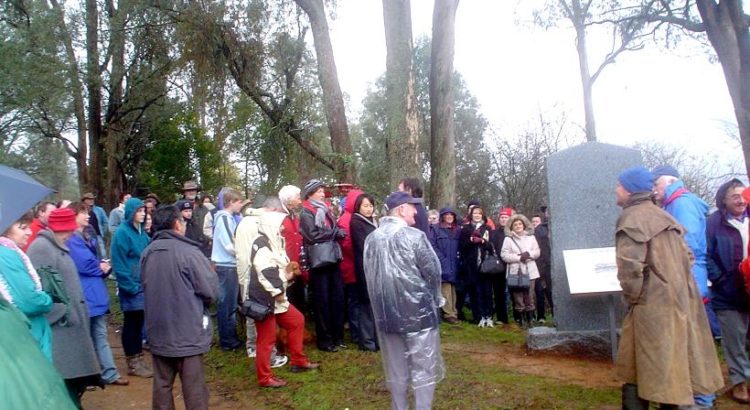A dedication ceremony for the commemorative monument to the Chinese who lost their lives or who are buried at the Buckland Valley: Report to Chinese Australian Family Historians of Victoria Inc. (CAFHOV) by Chris Neelima Lee.
The planned Chinese Australian Family Historians of Victoria (CAFHOV) dedication ceremony for the commemorative monument to the Chinese who lost their lives or who are buried at the Buckland Valley coincided with the one hundred and fiftieth anniversary of the riotous attack on the Chinese residents, their families and the miners of the Buckland Valley on July 4th 1857.
I have written at some length including my impressions of local events preceding the dedication ceremony because I believe the CAFHOV event was significant not just for the Victorian Alpine Region but also for racial reconciliation and healing in other communities in Australia . I believe that there is the potential in this event to mark the ending in a long period in Anglo-European discrimination of others of colour and differing ethnicity.
On June 23rd 2007, a Melbourne Age article focused on the forthcoming weekend celebrations in Bright in Victoria and described some of the legacies of the attack and their effect on the lives of Chinese Australian descendants.
The article reported how one elderly descendant recalled the variety of Chinese food she had eaten as a child. She told of the longstanding sadness of the injustice she had felt because her grandfather was one of more than 2000 Chinese miners caught in the Buckland race riot. In that article, the event organiser and local historian Diann Talbot was quoted as saying of the riot, “the tourist and farming community is ready to face the past”. Diann has extensively researched and written about the Buckland Valley Riot resulting in her book, The Buckland Valley Goldfields and published by Diann in 2004.
The dedication was to be the culmination of a three-year CAFHOV project, the Buckland Chinese Heritage Project. CAFHOV, in particular its chairperson, Kevin Wong Hoy had initiated the project which had included an archaeological dig. In the latter stages, the project was supported and funded by the Victorian Government through a Heritage Victoria Grant. Other assistance and resources were provided by the Alpine Shire and local historian, Diann Talbot.
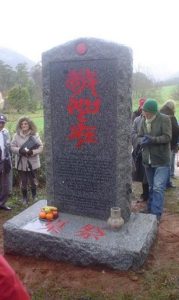
Buckland Memorial Stele, June 2007
A granite stele (memorial) and an interpretive storyboard both of which had been painstakingly researched, carved and installed under Kevin’s meticulous direction, was to be dedicated in a ceremonial unveiling. This ceremony was part of “A Celebration of Chinese History in the Ovens Valley” organised by the Bright and District Historical Society and supported by the Shire, the community and at least three of the district schools that had actively participated in preparation of the event over many months.
The program of events from Friday the 29th of June to Sunday 1st of July included the opening of a Chinese Joss House ( Temple ); a display of family histories and memorabilia presented by descendants, some of whom have links or still reside in the Alpine Shire.
Over the weekend there was a Chinese Celebration Parade which was well represented by the See Yup Society from Melbourne and the Bendigo Golden Dragon Chinese Museum ‘s all-girl dancing troupe. Descendants of local Chinese families were driven in an antique car motorcade and the traditional ceremonial Chinese Dragons and Lions were an enthusiastic and energetic troupe.
A feature of the community healing I observed was the display and presentation by the schools of the children’s artwork and stories which had been written as “stories to home” by taking the role as early Chinese miners and settlers. This contribution of so many children in the Shire had, I believe, built up local knowledge, interest and empathy prior to the weekend celebrations and presentations.
Too many other events and displays to detail here occurred at the weekend but there were two that I felt contributed greatly to the atmosphere in the community.
The first of these was the opening of the newly completed Chinese Joss House or temple in Bright. Back in July 1857, the newly arrived Chinese people had diligently and swiftly built not one, but as many as three temples in the Buckland Valley . Our story-teller felt that this had been one of the causes of the anger in the Anglo-European community who attacked and desecrated the newest of these temples that had only just been completed and opened a few days before the riot.
The opening of this new Chinese Joss House in Bright in 2007 appeared to descendants as a genuine gesture of reconciliation.
The second very moving moment came with the viewing in the Bright Art Gallery of the “Buckland Riot Screens” consisting of five large painted panels with a total width of eight metres. These were initially presented as two folded screens showing views of the beautiful Buckland countryside. Their opening to full width showing much of the story of the riot and an angry Anglo-European mob was both dramatic and startling.
The artist Thomas Lawler, whose family farmed in the Buckland for several generations and who knew the land and I would say, heard its whisperings, told us that the screens, when opened to capacity, revealed the often in the past hidden, painful and tragic story of the 1857 riot. Each screen he told us, contained representation of the five Chinese elements of fire, metal, earth, wood and water. On closer viewing of the panels, observers could see a traditional Chinese dragon weaving its way through the countryside. Its head and body are part of a fallen tree trunk over which the Buckland Chinese were attempting to escape across the raging and very cold waters of the Buckland River .
Many aspects of the attack depicted in the Buckland Riot screens have become known through recent historical research. One of the panels shows a tent being set alight while three Chinese inhabitants huddle inside in fear. It shows the attack on the European wife of a Chinese storekeeper, the desecration of the Chinese temple and Chinese people being thrown or falling into the icy water.
It was with this background atmosphere of sadness over man’s inhumanity to its fellow man along with the many positive acts of interest and concern experienced in our visit to Bright and the Chinese Celebration, that we walked up the hillside to prepare for the dedication and the unveiling of the stele and the interpretive storyboard. It was a cold and drizzly early Sunday morning as we approached the previously unmarked cemetery site. The first thing that we saw was the interpretive storyboard.
Kevin had, on advice, placed the granite stele to face north and this meant that its back faced the narrow country road. As we walked to the northern side, several of us were heard to gasp at the visual impact of the stele. The dedication tablet of grey Harcourt granite sits on a base that can serve as an offering table and is an impressive 2.5 metres high. The tablet has three large red Chinese characters which say, “Respect as if you were here” (translation). At the top of these is a red circle symbolic of the circle of life.
As my head lifted from the stele, my eyes fell to the distant surrounding mountains which appeared to gently and protectively enclose the monument. It was a powerful sight.
We clothed the stele and the storyboard in the appropriate silvery satin cloth and ties provided by Barbara Nichol, the Secretary of CAFHOV and awaited the arrival of the visitors who included Amy Chan from Heritage Victoria who was to dedicate the stele.
There were more than two hundred people who came to the countryside ceremony on that cold Sunday more than 150 years after the Buckland Riot.
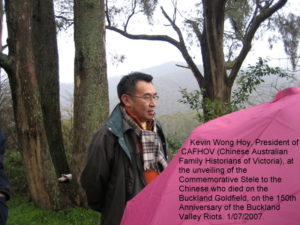
Kevin Wong Hoy (CAFHOV President) speaking at memorial ceremony, June 2007
Speakers included Jim Twycross who chaired the proceedings, Kevin Wong Hoy who spoked of the origins and development of the project and Amy Chan who spoke about the support role of Heritage Victoria . An opportunity was made for members of the community to comment and I had been assigned the role of facilitator for that session.
During this “open speak time” the Mayor of the Alpine Region spoke of the preceding years and what had been the beginnings of the tribute to the early Chinese settlers and the effects of the riot. As he concluded his words and turned to walk out of the speakers’ spot he turned back to say loudly, “Sorry”. There was a hush over the crowd and a considerable pause. I felt that suddenly this spot had become a focus point for the need to not only address past injustices but for the power of reconciliation through the act of making an apology.
After some silence, a local landowner spoke of a place known as “Chinaman’s hole” where one of the Chinese men was believed to have been thrown to his death. His speech was very moving as he recognised the many tragedies buried in the Buckland soil. It is these tragedies that I have called, “the whisperings in the Valley”.
Another speaker said that she wanted to bring Jesus and her Christian beliefs to the gathering. I felt that this might change the reconciliatory atmosphere. But in offering her Christian prayer for the event she concluded by saying that the valley had known violence, flood and bushfire but the hope was that the erection of the monument would now bring peace to the valley.
Again, there was a pause and the rain was softly falling when an elderly lady walked to the speaking spot and told us that her great grandfather was a miner in the Buckland Valley at the time of the riot. He was at the hotel meeting where the hostility that led to the riot was fermented. She went on to say that she was not sure if her grandfather was a part of the rioting group who attacked the Chinese. She was heard to say, “If he was, I apologise”. She went on to say that soon after that he drowned in the Buckland River.
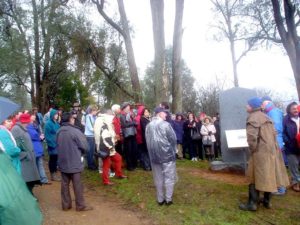
Gathering at memorial ceremony, June 2007
To me the meeting felt complete. People in the general community had spoken from their hearts. It seemed to me that from the groups that the speakers may once have represented – the farmers, the Christians, the Anglo-European miners and the government officials, who may have, at an earlier time, opposed the arrival of Chinese workers at the Australian goldfields, there had now been an apology. There was now a coming together as humanitarians in a community with an emerging base of sensitive children and adults learning a broader and different view of recent Australian history.
And they were feeling sorry and saying “sorry” for past racial discrimination. And they were feeling strongly enough to do something publicly about the cover-ups and past injustices and to powerfully hear and acknowledge the “whisperings in the Valley”.
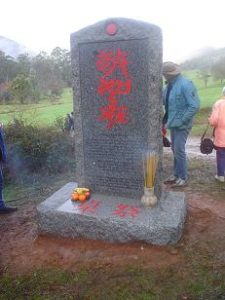
Buckland memorial stele, June 2007
